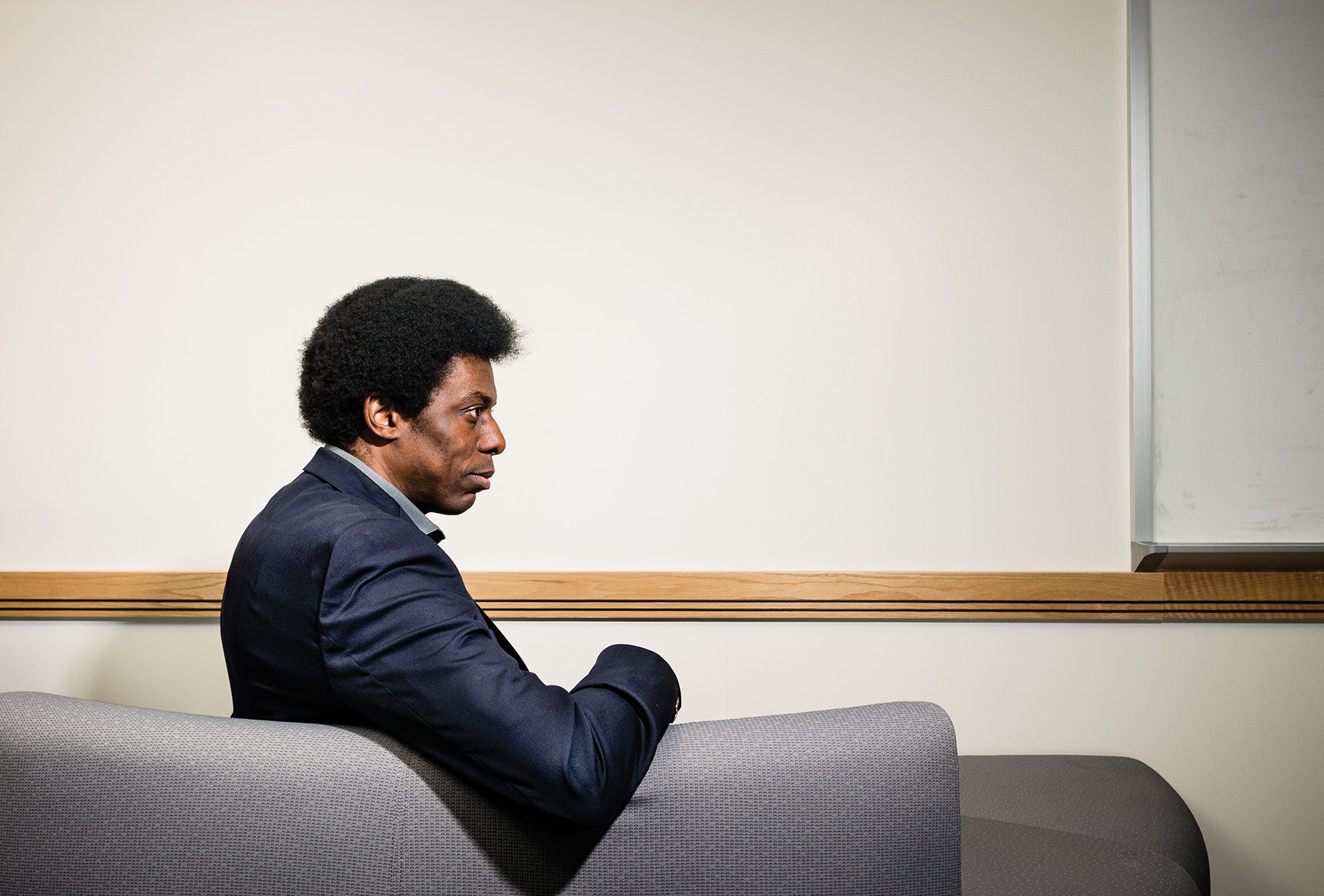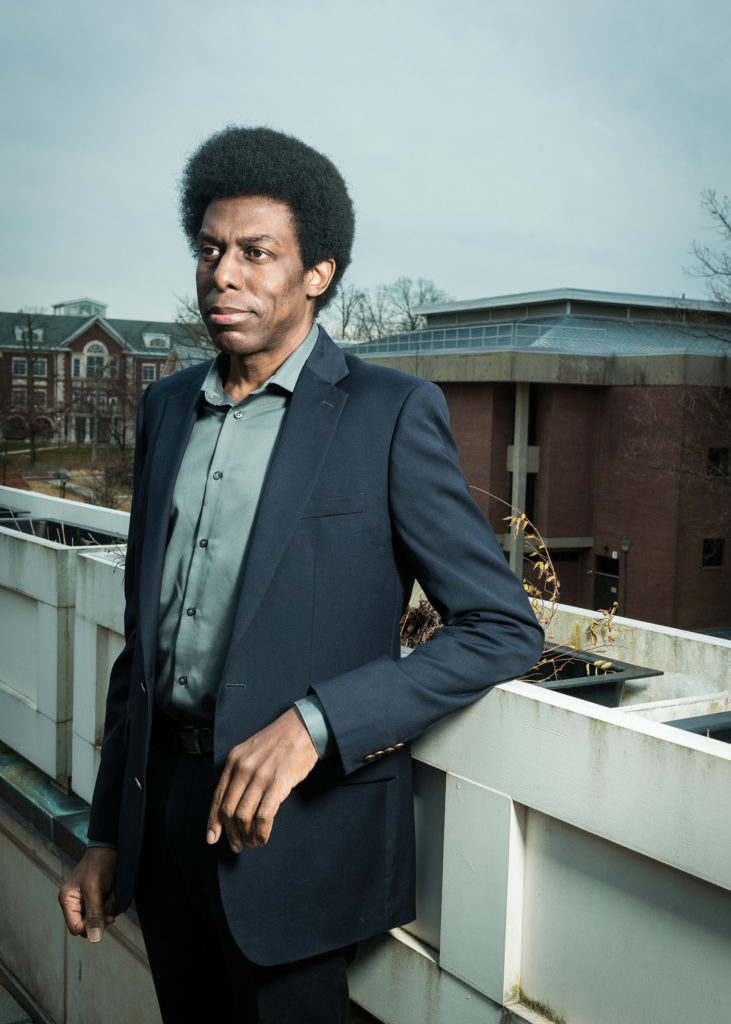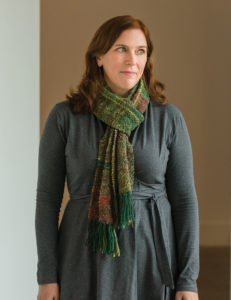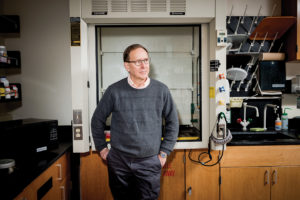Look the other way
Sometimes all a class needs is a new perspective.

David Bwire / Education / Culture / Professor at TCNJ
Faculty start to turn heads and change attitudes as they address inequities in program curricula.
Higher education has long wrestled with questions about inclusion and diversity, but there’s been an increased urgency since last summer’s racial protests to change the way we see the world and teach our students about it.
“What we really need to be thinking about is how can students who are pursuing a particular course of study understand racial inequity, social injustice, systemic and persistent racism within the context of that discipline,” says Jeffrey Osborn, a biologist who became TCNJ’s provost in July after 14 years as dean of the School of Science.
“We have to make structural and cultural changes in our academic disciplines and departments,” Osborn says. Change needs to happen not just along the edges — workshops, say, on white privilege or racial injustice — but at the core. Individual classes in every department can impart lasting lessons — that science, for instance, is not solely the province of white men; that English is not the universal language of humanity; that art from beyond the West is worthy of display in museums.
“What’s exciting is that this is already happening,” Osborn says about the way professors are broadening their course designs and the lessons in their classes. “They are engaged in this work at the departmental and school levels. This approach will have longterm impacts, ensuring that these efforts are woven into the fabric of the college’s curriculum.”
David Bwire
Communicating across cultures

“My students were upset,” says Bwire, who taught English and literature in Nairobi for 10 years before coming to the United States for his doctoral studies. They lived in a big city with plenty of buses, and they thought the Alaskans were mocking them for not knowing what one looked like. “They were like, ‘These guys think we come from Africa and we live in a jungle. They think we don’t know what a school bus is. How dare they?’”
But the Alaskans meant no offense. Bwire and his Kenyan students learned two lessons from that exchange — about what constituted a school bus in rural Alaska (anything that brought students to school, which, depending on the season, might be an ATV or a dogsled); but also about implicit miscommunication (how one person’s school bus can be another’s insult). That second lesson is the one he emphasizes to his TCNJ students.
“Implicit miscommunication is alive and rife in our classrooms,” says Bwire, an assistant professor in the Special Education, Language and Literacy Department, where his goal is to help TCNJ students — many of whom will go on to work in the polyphonic public schools of New Jersey — avoid this occupational hazard.
What you say in one language about one culture can mean something very different when translated into another language for another culture, and your attempt at communicating across the gap can be garbled inadvertently — like that school bus, or another example he uses, the Swahili word “pole,” which means “sorry,” but not quite in the same way that “sorry” means in English. When Bwire sees somebody trip on a sidewalk, his instinct is to say what common custom in Kenya taught him to say. “I would say ‘sorry’ because that is pole translated. But unlike sorry, pole doesn’t incriminate me, it doesn’t say I caused you to trip, I’m not apologizing for your tripping. What’s happening is that I am saying I sympathize with what you’ve just gone through,” he says. “The English word ‘sorry’ doesn’t carry the cultural nuances of the Swahili word.”
Bwire’s own travels across cultural borders — he speaks four languages and spent five summers in Vermont earning a master’s degree — sparked his interest in what became his academic field: sociolinguistics, with a specialty in transcultural literacy. He did part of his doctoral dissertation research in that Alaskan school-bus village, where he learned some Yup’ik from the elders.
“The objective is to get my students to understand that human language is broad, that we cannot be Anglocentric, monolingual-norm, Western-centric in our understanding of how human language works,” says Bwire. And he wants them to remember those lessons when they are teachers themselves. “One of the things I get my students to do is to reflect and ask themselves to what extent are they expecting that a student in their class should perform like a native speaker of English when they are non-native speakers of English?”
Sounds, like meanings, also change across languages, he tells his students, and some of those sounds are difficult for non-native speakers of a language to reproduce, and can sometimes lead teachers to misjudge a student’s progress. Recent immigrants from Spanish-speaking countries, for instance, form the “D” sound by touching the tongue to the teeth rather than to the ridge behind them, as native English speakers do, a pronunciation that might lead them to be wrongly placed in a remedial class. “What message are we giving a student who is bilingual by telling them that your bilingualism is a disability?” Bwire asks.
He further demonstrates this point by playing an audio of his own fumbling attempts, under the guidance of the Alaskans, to make the guttural sounds that are common in Yup’ik.
“We have to understand that we live in a world where there are other people, and know that there is that kind of broadness beyond us, beyond my language, beyond my culture, beyond my geographical boundaries, beyond my beliefs and practices,” he says. “A better understanding of self and other in the world can lead to better communication for everybody.”
Deborah Hutton
Bringing art out of the corners

At TCNJ she created her own curriculum of classes in South Asian, Islamic, and East Asian art. “I got very interested in this idea of global art history,” she says. “It led me to think about teaching differently. Why can’t we take a specific time period and look at it globally?”
To teach about the 16th century and not venture too far beyond the Sistine Chapel, or to see the 20th century through the lens of Jackson Pollock, is to ignore the ways that artists in the rest of the world were expanding the language of beauty and extending the boundaries of expression. “It gives the idea like I had when I was an undergrad that we only study Western art because that’s all that exists, rather than that was a conscious choice made by people,” she says.
The conscious choice she made was to introduce students to art from cultures they might have previously encountered only from other, narrower angles. “Which cultures are celebrated in art history, music, philosophy, and literature classes and which cultures are only taught in classes like terrorism or religious studies?” asks Hutton, who started teaching Islamic art in the year of 9/11. “What’s it like to be a student who has a connection to that culture and only sees that culture presented one way? That’s something that really shaped my entire teaching career, but I only get more adamant about it over time.”
As recipient of the Gitenstein-Hart sabbatical prize for faculty research, Hutton spent a year as part of a large team of authors working to rewrite the narrative of art history. Her global perspective will gain a wider audience this year with the publication of the textbook — “the first major art history survey textbook written in the 21st century,” according to the publisher — of which she is a co-lead author: The History of Art: A Global View. “With its own history rooted in European imperialism, art history has long idealized the art of Western Europe and White North America at the expense of art of other cultures,” the book’s introduction reads, emphasizing that it will instead examine “the meaning and significance of art from all six inhabited continents and their many cultures.”
Hutton has also introduced a new seminar that explored those deeper issues of racism and Eurocentrism in art history. “How can we make art history less racist?” she asks. “I don’t care if my students memorize a canon of objects that they can recognize when they go to a museum. I see what I do as making them global citizens and getting them to see the world in a new way that maybe goes beyond the way certain cultures are presented within our culture.”
Wendy Clement, Tracy Kress, and Donald Lovett
Brainstorming biology‘s bias

“Initially people would say, ‘Well what can you possibly do in the sciences about racism?’ and that’s what we may have thought initially, too,” says biology professor Donald Lovett. He and other faculty in the biology department “brainstormed ideas on how to be more explicit in pointing out biases and misunderstandings,” he says.
A failure to acknowledge the scientific contributions of women and people of color; the shameful legacy of eugenics; false notions about race; biological studies that ignored nonwhite populations — there was much ground to cover. Turns out, the biology department already had a vehicle that neatly accommodated addressing the issues: the introductory course for biology majors, Bio 201: Foundations of Biological Inquiry, which had been redesigned several years earlier by two professors in the department, Wendy Clement and Tracy Kress.
“We wanted to be inclusive about the diversity of learning styles,” Clement says. “There’s definitely a lot of work to be done, but I do think there is the framework to incorporate diversity now.”
In the Foundations class, professors guide students through questions and lead them toward answers, rather than providing the answers first in lectures. The texts include primary research articles, many by scientists who are neither white nor male.
“It’s that inquiry-based approach that they’re using to build those new activities and awareness, so I think it definitely gave a model to use to tackle that,” Kress says.
All four sections of the class use the same set of slides, and among the new ones added this year, in a discussion about the scientific method, is this: “How does one determine race? There is no genetic basis for race; it is a social construct.”
Later slides then expand on the point by showing how three different high-altitude populations — in Tibet, Bolivia, and Ethiopia — evolved different ways of adapting to life in thin oxygen. “This shows you that there is tremendous diversity among individuals that goes beyond the boxes of race,” says Lovett, who taught Foundations in the fall semester. “What that did was very explicitly, but subtly, say that race is not a real thing and science is not going to be used to talk about one race over another.”
COVID-19 offered another vivid lesson. As the virus started spreading last spring, the death rate was especially high among Blacks and Latinos. “There were actually people who were trying to find out what it was about minority groups that made them more susceptible, until some people took a step back and said, ‘Wait, it has nothing to do with race,’” Lovett says.
What made them more susceptible was economics — jobs that couldn’t shift to home computers, cramped living spaces where the virus spread more easily.
“What we’re trying to do is help people identify systemic racism and implicit bias, even when scientists would insist that the research is unbiased,” Lovett says. “Our goal is to help students identify that, but also affirm to our students of color that we’re trying to reverse this, that we are not merely standing on the sidelines.”
Photos: Peter Murphy
Posted on February 11, 2021

